
17 Out-of-Place Artifacts Said to Suggest High-Tech Prehistoric Civilizations Existed
By Tara MacIsaac, Epoch Times
According to the conventional view of history, humans have only walked the Earth in our present form for some 200,000 years. Advanced civilizations appeared several thousand years ago, but much of the mechanical ingenuity we know in modern times began to develop only around the Industrial Revolution a couple hundred years ago.
Oopart (out-of-place artifact) is a term applied to dozens of prehistoric objects found in various places around the world that seem to show a level of technological advancement incongruous with the times in which they were made.
Many scientists attempt to explain them using natural phenomena. Others say such explanations ignore the mounting evidence that prehistoric civilizations possessed advanced technological knowledge that was lost throughout the ages only to be redeveloped in modern times.
We will look at a variety of ooparts here ranging in purported origin from millions of years ago to merely hundreds of years ago, but all said to show advancement well ahead of their time.
We do not claim that all or any of the ooparts are definitive evidence of advanced prehistoric civilizations, but rather attempt to provide a brief glimpse at what’s known or hypothesized about these artifacts. This is not a comprehensive list of all ooparts, but it is a substantial sampling.
17. 2,000-Year-Old Batteries?
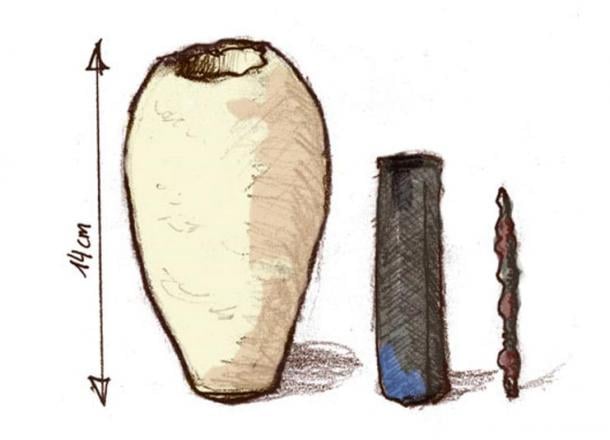
Right: An illustration of a Baghdad battery from museum artifact pictures. (Ironie/Wikimedia Commons)
Clay jars with asphalt stoppers and iron rods made some 2,000 years ago have been proven capable of generating more than a volt of electricity. These ancient “batteries” were found by German archaeologist Wilhelm Konig in 1938 just outside of Baghdad, Iraq.
“The batteries have always attracted interest as curios,” Dr. Paul Craddock, a metallurgy expert at the British Museum, told the BBC in 2003. “They are a one-off. As far as we know, nobody else has found anything like these. They are odd things; they are one of life’s enigmas.”
16. Ancient Egyptian Light Bulb?
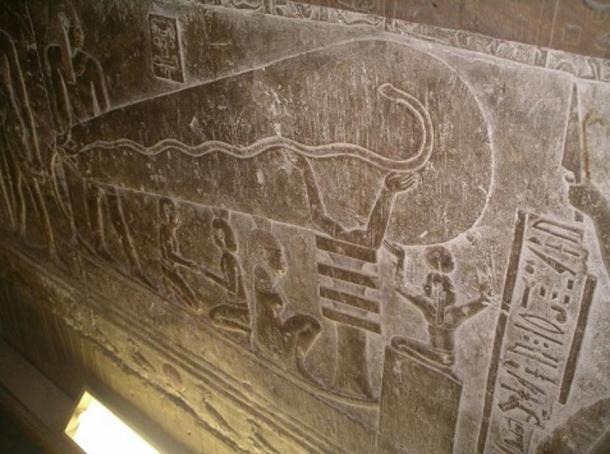
The light-bulb-like object engraved in a crypt under the Temple of Hathor in Egypt. (Lasse Jensen/Wikimedia Commons)
A relief beneath the Temple of Hathor at Dendera, Egypt, depicts figures standing around a large light-bulb-like object. Erich Von Däniken who wrote “Chariot of the Gods,”created a model of the bulb which works when connected to a power source, emitting an eerie, purplish light.
15. Great Wall of Texas
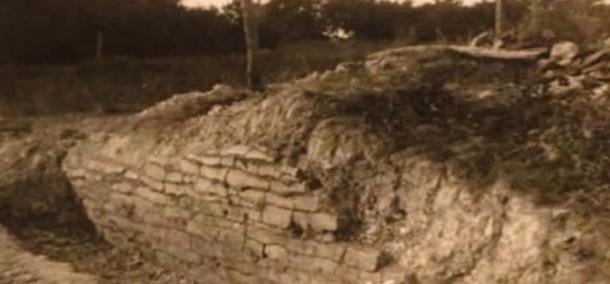
A historic photo of the “wall” found in Rockwall, Texas. (Public Domain)
In 1852, in what is now known as Rockwall Co., Texas, farmers digging a well discovered what appeared to be an ancient rock wall. Estimated to be some 200,000 to 400,000 years old, some say it’s a natural formation while others say it’s clearly man-made.
Dr. John Geissman at the University of Texas in Dallas tested the rocks as part of a History Channel documentary. He found they were all magnetized the same way, suggesting they formed where they are and were not moved to that site from elsewhere. But some remain unconvinced by this single TV-show test and ask for further studies.
Geologist James Shelton and Harvard-trained architect John Lindsey have noted elements that seem to be of architectural design, including archways, linteled portals, and square openings that resemble windows.
14. 1.8-Billion-Year-Old Nuclear Reactor?
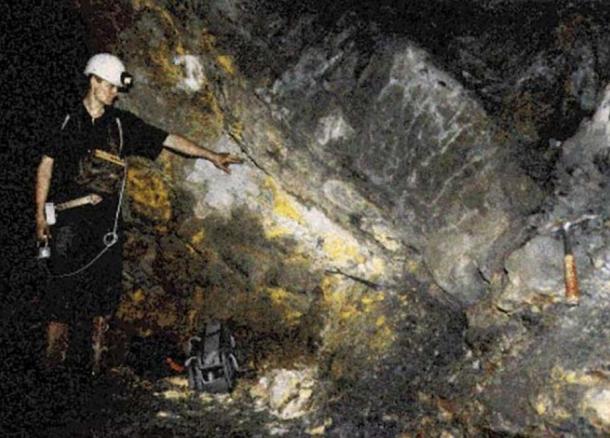
Nuclear reactor site, Oklo, Gabon Republic. (NASA)
In 1972, a French factory imported uranium ore from Oklo, in Africa’s Gabon Republic. The uranium had already been extracted. They found the site of origin to have apparently functioned as a large-scale nuclear reactor that came into being 1.8 billion years ago and was in operation for some 500,000 years.
Dr. Glenn T. Seaborg, former head of the United States Atomic Energy Commission and Nobel Prize winner for his work in the synthesis of heavy elements, explained why he believes it wasn’t a natural phenomenon, and thus must be a man-made nuclear reactor. For uranium to “burn” in a reaction, very precise conditions are needed.
The water must be extremely pure, for one. Much purer than exists naturally. The material U-235 is necessary for nuclear fission to occur. It is one of the isotopes found naturally in uranium. Several specialists in reactor engineering have said they believe the uranium in Oklo could not have been rich enough in U-235 for a reaction to take place naturally.
13. Sea-Faring Map Makers Before Antarctica Was Covered in Ice?
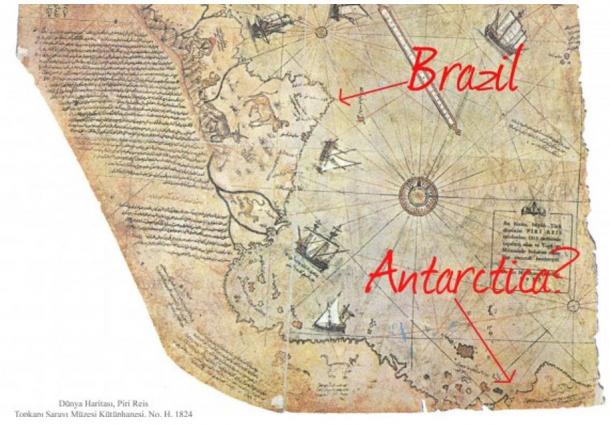
A portion of the Piri Reis map of 1513. (Public Domain)
A map created by Turkish admiral and cartographer Piri Reis in 1513, but sourced from various earlier maps, is thought by some to depict Antarctica as it was in a very remote age before it was covered with ice.
A landmass is shown to jut out from the southern coastline of South America. Captain Lorenzo W. Burroughs, a U.S. Air Force captain in the cartographic section, wrote a letter to Dr. Charles Hapgood in 1961 saying that this landmass seems to accurately show Antarctica’s coast as it is under the ice.
Dr. Hapgood (1904–1982) was one of the first to publicly suggest that the Piri Reis map depicts Antarctica during a prehistoric time. He was a Harvard-educated historian whose theories about geological shifts earned the admiration of Albert Einstein. He hypothesized that the land masses shifted, explaining why Antarctica is shown as connected to South America.
Modern studies refute Hapgood’s theory that such a shift could have taken place within thousands of years, but they show that it could have happened within millions of years.
12. 2,000-Year-Old Earthquake Detector

A replica of an ancient Chinese seismoscope from the Eastern Han Dynasty (25-220 A.D.), and its inventor, Zhang Heng. (Wikimedia Commons)
In 132 A.D., Zhang Heng created the world’s first seismoscope. How exactly it works remains a mystery, but replicas have worked with a precision comparable to modern instruments.
In 138 A.D., it correctly indicated that an earthquake occurred about 300 miles west of Luoyang, the capital city. No one had felt the quake in Luoyang and dismissed the warning until a messenger arrived days later requesting aid.
11. 150,000-Year-Old Pipes?
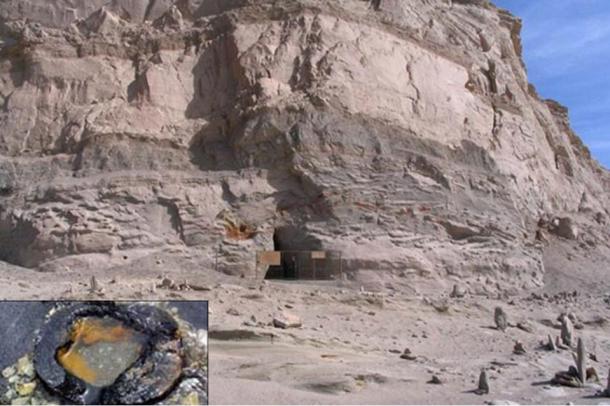
Baigong Cave, with photo of pipe in the bottom left
Caves near Mount Baigong in China contain pipes leading to a nearby lake. They were dated by the Beijing Institute of Geology to about 150,000 years ago, according to Brian Dunning of Skeptoid.com.
State-run media Xinhua reported that the pipes were analyzed at a local smeltery and 8 percent of the material could not be identified. Zheng Jiandong, a geology research fellow from the China Earthquake Administration told state-run newspaper People’s Daily in 2007 that some of the pipes were found to be highly radioactive.
Jiandong said iron-rich magma may have risen from deep in the Earth, bringing the iron into fissures where it may have solidified into tubes. Though he admitted, “There is indeed something mysterious about these pipes.” He cited the radioactivity as an example of the strange qualities of the pipes.
10. Antikythera Mechanism

The Antikythera Mechanism is a 2000-year-old mechanical device used to calculate the positions of the sun, moon, planets, and even the dates of the ancient Olympic Games. (Wikimedia Commons)
A mechanism, often referred to as an ancient “computer,” that was built by Greeks around 150 B.C. was able to calculate astronomical changes with great precision.
“If it hadn’t been discovered … no one would possibly believe that it could exist because it’s so sophisticated,” said Mathematician Tony Freeth in a NOVA documentary. Mathias Buttet, director of research and development for watch-maker Hublot, said in a video released by the Hellenic Republic Ministry of Culture and Tourism, “This Antikythera Mechanism includes ingenious features which are not found in modern watch-making.”
9. Drill Bit in Coal
John Buchanan, Esq., presented a mysterious object to a meeting of the Society of Antiquaries of Scotland on Dec. 13, 1852. A drill bit had been found encapsulated in coal about 22 inches thick, buried in a bed of clay mixed with boulders about 7 feet thick.
The Earth’s coal is said to have formed hundreds of millions of years ago. The Society decided that the instrument was of a modern level of advancement. But, it concluded that “the iron instrument might have been part of a borer broken during some former search for coal.”
Buchanan’s detailed report did not include any signs that the coal surrounding the instrument had been punctured by drilling.
8. 2.8-Billion-Year-Old Spheres?

Top left, bottom right: Spheres, known as Klerksdorp spheres, found in the pyrophyllite (wonderstone) deposits near Ottosdal, South Africa. (Robert Huggett) Top right, bottom left: Similar objects known as Moqui marbles from the Navajo Sandstone of southeast Utah. (Paul Heinrich)
Spheres with fine grooves around them found in mines in South Africa have been said by some to be naturally formed masses of mineral matter. Others have said they were precisely shaped by a prehistoric human hand.
“The globes, which have a fibrous structure on the inside with a shell around it, are very hard and cannot be scratched, even by steel,” said Roelf Marx, curator of the museum of Klerksdorp, South Africa, according to Michael Cremo’s book “Forbidden Archaeology: The Hidden History of the Human Race.” Marx said the spheres are about 2.8 billion years old.
If they are mineral masses, it is unclear how exactly they formed.
7. Iron Pillar of Delhi

An inscription from about 400 A.D. by King Candragupta II on the Iron Pillar of Delhi. (Venus Upadhayaya/Epoch Times)
This pillar is at least 1,500 years old, but could be older. It remains rust-free and is of an astounding purity. It is 99.72 percent iron, according to professor A.P. Gupta, head of the Department of Applied Sciences and Humanities at the Institute of Technology and Management in India.
In modern times, wrought iron has been made with a purity of 99.8 percent, but it contains manganese and sulfur, two ingredients absent in the pillar.
It was made at least “400 years before the largest known foundry of the world could have produced it,” wrote John Rowlett in “A Study of the Craftsmen of Ancient and Medieval Civilizations to Show the Influence of their Training on our Present Day Method of Trade Education.”
6. Viking Sword Ulfbehrt

An Ulfberht sword displayed at the Germanisches Nationalmuseum, Nuremberg, Germany. (Martin Kraft/Wikimedia Commons)
When archaeologists found the Viking sword Ulfbert, dating from 800 to 1000 A.D., they were stunned. They couldn’t see how the technology to make such a sword would have been available until the Industrial Revolution 800 years later.
Its carbon content is three times higher than other swords of its time and impurities were removed to such a degree that the iron ore must have been heated to at least 3,000 degrees Fahrenheit.
With great effort and precision, modern blacksmith Richard Furrer of Wisconsin forged a sword of Ulfberht quality using technology that would have been available in the Middle Ages. He said it was the most complicated thing he’d ever made, and he used methods not known to have been used by people of that time.
5. 100-Million-Year-Old Hammer?
A hammer was found in London, Texas, in 1934 encased in stone that had formed around it. The rock surrounding the hammer is said to be more than 100 million years old.
Glen J. Kuban, a vocal skeptic of claims the hammer was made millions of years ago, said the stone may contain materials that are more than 100 million years old, but that doesn’t mean the rock formed around the hammer so long ago.
Some limestone has formed around artifacts known to be from the 20th century, so concretions can form fairly quickly around objects, he said. Concretions are masses of hardened mineral matter.
Carl Baugh, who is in possession of the artifact, has said the wooden handle has turned to coal (evidence of its great age) and that the metal it is made of has a strange composition. Critics have called for more, independent testing to verify these claims, but thus far no such testing has been conducted.
4. Prehistoric Work Site?
Workers at a stone quarry near Aix-en-Provence, France, in the 18th century came across tools stuck in a layer of limestone 50 feet underground.
The find was recorded in the American Journal of Science and Arts in 1820 by T. D. Porter, who was translating Count Bournon’s work, “Mineralogy.”
The wooden instruments had turned into agate, a hard stone. Porter wrote: “Everything tended to prove that this work had been executed upon the spot where the traces existed. The presence of man had then preceded the formation of this stone, and that very considerably since he was already arrived at such a degree of civilization that the arts were known to him, and that he wrought the stone and formed columns out of it.”
As stated in the case of the hammer above, limestone has been known to form relatively quickly around modern tools.
3. Million-Year-Old Bridge?

Adam’s Bridge, also known as Rama’s Bridge, or Ram Setu, between India and Sri Lanka. (NASA)
According to ancient Indian legend, King Rama built a bridge between India and Sri Lanka more than a million years ago. What appears to be remnants of such a bridge have been seen from satellite images, but many say it is a natural formation.
Dr. Badrinarayanan, former director of the Geological Survey of India, studied core samples from the bridge. He was puzzled by the appearance of boulders on top of a marine sand layer, and surmised that the boulders must have been artificially placed there.
No single natural explanation has been agreed upon by geologists. Dating has been controversial, as some say any given part of the bridge (such as coral samples) cannot give a true picture of how old the entire bridge is.
2. 500,000-Year-Old Spark Plug?
In 1961, three people were out searching for geodes for their gem and gift shop in Olancha, Calif., when they found what appeared to be a spark plug encased in a geode. Virginia Maxey, one of the three discoverers, said at the time that a geologist examined the fossils around the device and dated the device at 500,000 years or older.
The geologist was never named, and the current whereabouts of the artifact are unknown. Critics of the claim, Pierre Stromberg and Paul V. Heinrich, only have x-rays and an artist’s sketch of the artifact to analyze. They think it was a modern spark plug encased in a quick-forming concretion rather than a geode.
But, Stromberg and Heinrich have said, “There is little hard evidence that the original discoverers intended to deceive anyone.”
1. Prehistoric Wall Near Bahamas?
A wall of rock in large, thick block shapes was found off the coast of the Bahamas in 1968. Archaeologist William Donato has conducted multiple dives to investigate the wall and hypothesizes it is a man-made structure some 12,000 to 19,000 years old built to protect a prehistoric settlement from waves.
He’s found it to be a multi-tiered structure including prop stones that appear to be placed there by human hands. He’s also found what he believes to be anchor stones with rope holes in them.
Dr. Eugene Shinn, a retired geologist who worked for the U.S. Geological Survey, has said core rock samples he took show a dip toward deep water. If all the cores show a dip toward deep water, this would prove the rock formed where it is and did not form elsewhere later to be transported by humans to its present location.
His later writings said that all of his samples showed this dip, seeming to prove it is a natural formation. But his earlier study stated that only 25 percent of his samples showed a dip.
Dr. Greg Little, a psychologist who has taken an interest in this structure, confronted Shinn about this discrepancy and Shinn admitted he didn’t really take his study seriously and, “I got a little carried away to make a good story.”
The article ‘17 Out-of-Place Artifacts Said to Suggest High-Tech Prehistoric Civilizations Existed’ was originally published on The Epoch Times and has been republished with permission.
















Comments
The big question is, was the Ice Age, which began suddenly about 120,000 years ago actually a man-made nuclear winter that did not subside until what is called “the dawn of civilization” around just 10,000 years ago, in Sumer? Only stone ruins and non-ferrous metals would have survived the entropic effect of all those years. Iron implements would all be dust, and the only bones to be found would be those deep enough in the somewhat protected caverns. But perhaps the even greater mystery is that the Sumerians write about aboriginal non-Sumerians that had survived and had a culture, and of course the ancient Greeks carried forward mythology and a Pantheon of characters, as well as knowledge of Atlantis, all suggesting an earlier culture associated with the ruins that were resettled.
Nobody gets paid to tell the truth.
The explanation is almost certainly quite simple. And yet so utterly terrifying that most people prefer to pass on by and pretend such a thing is out of the question. Put baldly and simply our planet undergoes what you might call a 'Planetary Reset' roughly every 12,500 years, provoked by the natural cycles of our Sun. You'd like some evidence? Certainly. You don't have to suspend disbelief. You just to know where to look. Let me point you in the right direction. Start off by going to the UnchartedX channel on Youtube and puzzle over the huge lumps of expertly worked decorative masonry in Egypt, weighing many tons, smashed asunder and strewn across the landscape as if by a mighty hand. If you are prepared to spend some time working your way through some of the other videos on this channel you will also be introduced to such things as the walls in Macchu Picchi in the High Andes Mountains, the base stones of which are fashioned in ways we would have trouble duplicating today. And we are supposed to believe they did it all with bronze tools, which are incapable of working stone of this hardness, never mind the fact that the stone blocks come from a quarry a great distance away and would have had to be propelled somehow up the mountain.
Now, perhaps, you would like some technical evidence. No problem at all. Go to the SuspiciousObservers channel. Start off with the Classified : CIA video (yes some of the info in it really was classified until recently, and even now they have only released a small redacted portion of the material). Then think about the fact that every government in the world that has the capability and the money is building huge underground tunnels, bunkers and shelters. Even little Finland has one. What for? What are they expecting to happen? I think by this time you are beginning to understand. Our ancestors have started all over again from scratch many times. Usually just a pitiful few of them survive I would think. And the new civilisations they have formed may often have developed in a very different way from our own and may thus have achieved different types of abilities from our own which we find difficult to fully comprehend.
"A nation can survive its fools and and even the ambitious but it cannot survive treason from within. An enemy at the gates is less formidable..."
- Cicero, greatest orator of ancient Rome
If there was 'advanced technology', more then we think, there would be more versions of the same thing found all over the place.
These random artifacts suggests that from time to time someone would figure out something above the standard level of technology for that time no that the ancient world over all knew much more then we think.
People really need to stop watching ancient aliens if they are going to think its real. Sure somethings, but come on.
Furthermore, the whole world is under surveillance by satellites at this point. Alien visitors? Really?
No offense, but its ignorance at earth science and physics, a realistic grasp on available technology and too many conspiracy forms that ends up with ideas like magic crystals and metaphysical sky gods who where created by savage middle eastern slaves.
The more educated you are th more that you realize that a lot of this stuff is made up by people who have no idea what they are talking about.
Check your sources. Where does the original information come from? Is this person cerdiable? Do they even exist?
No, WIKI isn't a good source.
Respected Higher Dignitaires , I have so enthusiastic to analyze the human explosion in micro also macro existential themes . Intelligence of time and life and other systems inexploratory methodologies . Thank you
"...prehistoric civilizations possessed advanced technological knowledge that was lost throughout the ages only to be redeveloped in modern times."
There are anomalies out there that we STILL can't reproduce, such as the huge trilithons at Baalbek, and the small diorite Egyptian bottles that are hollow.
Pages